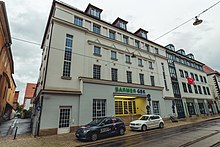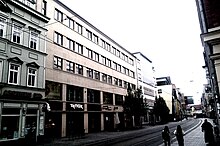Cinema in Erfurt

The article Kino in Erfurt deals with the history and current situation of the cinemas in Erfurt.
history
1905–1922: The beginnings by Theodor Scherff
The first film screenings in Erfurt took place in a 20 by 8 meter mobile film projection tent called the “Theater of Living Photographs”, which the Central German film pioneer Theodor Scherff (1857–1931) first presented at the Leipzig Autumn Fair in 1898 and with which he started since went from fair to fair. In 1905 he and Richard Janson set up one of his first stationary cinemas with 200 seats in Erfurt, Fischmarkt 11, which he called Scherff's Bioskop Theater . Other cinemas followed, (at that time still called Kintopp ) in Weimar , Leipzig , Grimma , Apolda and Gotha . Since the films were bought by him in the Berlin production companies, it made sense as the operator of several kintopps to create a circulation system. Other cinema operators followed his example, so that by the end of the First World War 16 cinemas had been built in Erfurt, mostly by converting older halls.

With the following upswing in the film industry during the Weimar Republic , the demands of visitors and the size of the halls grew. As early as 1918 Julius Ritter from Halle converted the former ballroom of the local brewery restaurant behind Haus Anger 57 into a large cinema, the Angertheater , which with 908 seats surpassed all other cinemas and a little later was expanded to 1000 seats. In the following year, Ritter opened another cinema in the Tivoli brewery restaurant, Magdeburger Strasse 51, today Magdeburger Allee 4, initially with 170 seats, which was expanded to 450-500 seats in 1924.
1922–1930: Karl Liebrich's rise as the king of the cinema
In June 1922, the entrepreneur Karl Liebrich and his architect Max Bischoff, who had already planned several cinema palaces in Berlin, including the Alhambra cinema on Kurfürstendamm 68, submitted a building application for the first new cinema in Erfurt, which was in a vacant lot on Johannesstrasse 164 and with almost 1200 seats should surpass all other cinemas. After over-planning by Karl Zöll, the cinema was completed in 1924 and also called the Alhambra . In the same year Liebrich also took over the management of the Erfurter Kammer-Lichtspiele in the former Preußischer Hof, Meyfartstraße 23. Of the mostly older cinemas from the pre-war period, only the Roland cinema in the Haus zum Roten Ochsen on the Fischmarkt with 510 seats survived . In 1926 Liebrich also acquired the Angerlichtspiele from Julius Ritter . Together with Gustav Schneider, Liebrich also acquired the three leading cinemas in Weimar from 1927 to 1929: the Zentral-Palast , Hummelstr. 4, with 1,100 seats, the Scherffs Lichtspiele , Marktstraße 20, with 650 seats and the Kammerlichtspiele , Marienstraße 1, with 400 seats. This made Liebrich & Schneider the largest cinema operator not only in Erfurt, but in the entire region. Liebrich & Schneider broke new ground with the planning of the Union cinema in Ilversgehofen. On the one hand, the location was far from the center in the Erfurt district of Ilversgehofen , which at the time was very industrial and was inhabited by many working-class families. On the other hand, the cinema specialist Carl Fugmann planned a radically modern style which, with its striking expressionist architecture, refers to Dutch models and the Weimar Bauhaus . The asymmetrical design with partly penetrating structures, cornices and neon signs, flat roofs and horizontal ribbon windows became characteristic. After the construction work had already started in April 1929, the building permit followed on May 12, 1929 and the opening on September 7, 1929. The house had over 900 seats.
1930–1945: The UFA era

The largest German film company at the time, UFA , founded in 1917 , was bought up after a crisis in 1927 by the media entrepreneur Alfred Hugenberg , who tried to promote the distribution of the films produced by the UFA through its own cinemas. In this context, it made sense to take part in the construction of a large commercial building complex, the Phoenix House , in the course of expanding Bahnhofstrasse as a metropolitan shopping street, in order to build a new large cinema palace there. With 1200 seats (850 in the stalls and 350 in the tier), the UFA-Palast is the largest and most modern cinema building in Erfurt to date. The construction method was shaped by the principles of young modernism, with reinforced concrete skeleton construction , continuous ribbon windows, flat roof and facade cladding made of square artificial stone elements. The filigree advertising lettering on the facade was equipped with neon lighting . In 1931 the UFA Palace was opened.
As a result of the de facto nationalization of the UFA from 1937 by the Cautio Treuhand on behalf of Joseph Goebbels , the UFA Palace was modernized again in 1939.
After 1945: GDR times, takeovers, demolitions and Cinestar multiplex

After the Second World War , relatively little changed in the Erfurt cinema landscape. The UFA-Palast remained nationalized and was the most important cinema in Erfurt during the GDR era . In 1967 it was modernized again and then called Panorama-Filmpalast . The other cinemas were also nationalized. The Union Cinema became the Theater of the Youth and the Roland Cinema was initially the Theater of German-Soviet Friendship , but closed in 1965. In 1975, as part of the cautious liberalization tendencies after Honecker took office, the cinema club on Hirschlachufer 1 was founded as one of the first cinema clubs in the GDR. It was initially directed by Barbara Hejlik and from 1982 by Dagmar Wagenknecht. The cinema club had more freedom in designing the program and also had access to a larger selection of films and was therefore able to offer special and critical films beyond the "mainstream" in a smaller, more exclusive setting.
After the fall of the Wall in 1990, the four old Erfurt cinemas were re-privatized by the Treuhandanstalt . The Union-Kino and the Panorama-Filmpalast were sold to Ufa-Theater AG in 1991 . In the same year a Filmtheater Betriebs-GmbH Erfurt was founded to support the Angertheater and the Alhambra , which was acquired in 1992 by the Lübeck cinema operator Kieft & Kieft Filmtheater GmbH . The Angertheater was initially converted into a box cinema with four halls and 1026 seats and in 1993/94 the operation, now called Anger Filmpalast , was expanded to 1295 seats in seven halls. The Alhambra was in operation until 1997. Afterwards, Kieft & Kieft sold the building to a private developer who had it demolished except for the historic facade and replaced by an administration building.
2001 could Kieft & Kieft a new Cinestar - multiplex cinema in a new building at Hirschlachufer 7 build and Anger movie palace then close. In October 2002 the UFA-Theater AG, which had the Union-Kino demolished in March 1998, went bankrupt. In 2003, Kieft & Kieft also took over the Panorama Cinema, which UFA had converted into a box cinema with nine halls and 1922 seats a few years earlier. The Panorama was also closed a short time later and the Phoenix House was sold. The house of the former Anger-Filmpalast was also sold for conversion as a residential and commercial building and the historic hall building was demolished in 2006.
Today (2018) only the Cinestar multiplex cinema with eight halls and 2158 seats on Hirschlachufer 7 and the gradually renovated cinema club with a hall of 60 seats on Hirschlachufer 1 still exist.
Table of the Erfurt cinemas
| year | Surname | address | operator | Places | comment |
|---|---|---|---|---|---|
| 1905 | Scherff's Bioskop Theater | Fish market 11 | Theodor Scherff, Richard Janson | 200 | |
| 1906 | Central Theater 4 | Friedrich-Wilhelm-Platz (Domplatz) | |||
| 1907 | Colosseum | Krmpferstrasse 62a | Max Francke | 250 | Closed in 1922 |
| 1908 | Edison Theater | Löberstrasse 17-18 | |||
| 1908 | People's Cinema Theater | Johannesstrasse 91-92 | H. White leather | 250 | |
| 1908 | Central cinematograph | Ilversgehofen, Hauptstr. 11 | |||
| 1909 | Apollo theater | Anger 27 | Otto Kunath, Hermann Conradus | 225 | Closed in 1922 |
| 1910 | Chamber light games | Trommsdorffstrasse 1 | 348 | ||
| 1911 | Motion picture theater | Bommersdorferstrasse 1 (?) | |||
| 1911 | Union Theater | Michaelisstrasse 30th | now "Theater im Palais" | ||
| 1913 | Rolandkino - DSF theater | Fish market 7 | Hermann Liemann, Kruppa & Co. | 565 | Closed in 1965 |
| 1915 | Karthaus | Kartäuserstraße 13a | |||
| 1916 | Thuringian forest play of light | Bahnhofstrasse 1 | 500 | ||
| 1917 | Chamber light plays Preussischer Hof | Am Anger / Meyfartstrasse 23 | Harry Wentzel, Karl Liebrich, Gustav Schneider | 600 | Closed in 1951 |
| 1917 | Reichshallen Theater | Dalbergsweg 2 | hate | ||
| 1918 | Anger film palace | Anger 57 | Julius Ritter, Karl Liebrich, Gustav Schneider, Cinestar (Kieft) | 1000 | In 1993 rebuilt to 7 halls and 1,410 seats, closed in 2001, demolished in 2006 |
| 1919 | Tivoli theater | Magdeburger Str. 51 (Magdeburger Allee) | Julius Ritter, Hugo Krug | 450 | Closed in 1927 |
| 1920 | Lichtspieltheater Auenkeller | At the Auenschanze 1–2 | Dockhorn & Peters | 450 | |
| 1921 | Othello-Lichtspiele - Filmbühne Gispersleben | Kopernikusplatz 5 | Hugo Müller, Josef Steidl | 284 | Closed in 1991 |
| 1924 | Alhambra | Johannesstrasse 164 | Karl Liebrich, Gustav Schneider | 1200 | Closed in 1998 and rebuilt |
| 1928 | Union-Kino - Theater of Youth | Magdeburger Allee 144 | Karl Liebrich, Gustav Schneider, Ufa-Theater AG | 900 | Closed in 1993, canceled in 1998 |
| 1931 | UFA-Palast - Panorama-Filmpalast | Bahnhofstrasse 41-44 | Ufa-Theater AG | 1177 | 1992 rebuilt to 9 halls with 1950 seats, closed in 2006 |
| 1975 | Cinema club on the Hirschlachufer | Hirschlachufer 1 | Initiative Kommunales Kino Erfurt eV | 60 | Direction: 1975 Barbara Hejlik, 1982 Dagmar Wagenknecht, 2013 Petra Beltz |
| 2001 | Cinestar (Kieft) | Hirschlachufer 7 | Cinestar (Kieft) | 2158 | Multiplex cinema with 8 halls |
literature
- Steffen Raßloff : Cinemas in the Weimar Republic. In: Thüringer Allgemeine , Erfurt edition, from December 27, 2008 ( online at erfurt-web.de , last accessed on May 21, 2018)
- Mark Escherich: Urban Self-Image and Structural Representation. Architecture and urban development in Erfurt 1918–1933. Lukas Verlag, Erfurt 2010, ISBN 978-3-86732-062-7 .
- Holger Wetzel: Apartments and shops are being built on the “Unne” wasteland in Ilversgehofen. In: Thüringer Allgemeine , Erfurt edition, from January 15, 2016 ( online as a paid offer)
Web links
- Filmtheater.Square7 for Thuringia
- Erfurt cinema history with many articles from the historical magazine Stadt und Geschichte. Magazine for Erfurt
Individual evidence
- ↑ Marcus Behnsen-Herbach: The world cinematograph from Eisenberg. In: OTZ.de (Ostthüringer Zeitung), March 14, 2017.
- ↑ The cinematograph No. 989: Mr. Karl Lieberich, owner and director of the Alhambra Erfurt (1200 seats) has now also acquired the Angerlichtspiele Erfurt (1000 seats). January 31, 1926
- ↑ site Kinoklub Erfurt , accessed on 7 April 2018th
